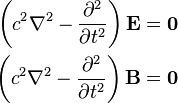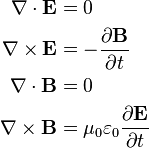Electromagnetic wave equation
The electromagnetic wave equation is a second-order partial differential equation that describes the propagation of electromagnetic waves through a medium or in a vacuum. It is a three-dimensional form of the wave equation. The homogeneous form of the equation, written in terms of either the electric field E or the magnetic field B, takes the form:
where
is the speed of light in a medium with permeability (μ0), and permittivity (ε0), and ∇2 is the Laplace operator. In a vacuum, c = 299,792,458 meters per second, which is the speed of light in free space.[1] The electromagnetic wave equation derives from Maxwell's equations. It should also be noted that in most older literature, B is called the magnetic flux density or magnetic induction.
The origin of the electromagnetic wave equation

In his 1865 paper titled A Dynamical Theory of the Electromagnetic Field, Maxwell utilized the correction to Ampère's circuital law that he had made in part III of his 1861 paper On Physical Lines of Force. In Part VI of his 1864 paper titled Electromagnetic Theory of Light,[2] Maxwell combined displacement current with some of the other equations of electromagnetism and he obtained a wave equation with a speed equal to the speed of light. He commented:
The agreement of the results seems to show that light and magnetism are affections of the same substance, and that light is an electromagnetic disturbance propagated through the field according to electromagnetic laws.[3]
Maxwell's derivation of the electromagnetic wave equation has been replaced in modern physics education by a much less cumbersome method involving combining the corrected version of Ampère's circuital law with Faraday's law of induction.
To obtain the electromagnetic wave equation in a vacuum using the modern method, we begin with the modern 'Heaviside' form of Maxwell's equations. In a vacuum- and charge-free space, these equations are:
These are the general Maxwell's equations specialized to the case with charge and current both set to zero. Taking the curl of the curl equations gives:
We can use the vector identity
where V is any vector function of space. And
where ∇V is a dyadic which when operated on by the divergence operator ∇ ⋅ yields a vector. Since
then the first term on the right in the identity vanishes and we obtain the wave equations:
where
is the speed of light in free space.
Covariant form of the homogeneous wave equation

These relativistic equations can be written in contravariant form as
where the electromagnetic four-potential is
with the Lorenz gauge condition:
and where
is the d'Alembert operator.
Homogeneous wave equation in curved spacetime
The electromagnetic wave equation is modified in two ways, the derivative is replaced with the covariant derivative and a new term that depends on the curvature appears.
where  is the Ricci curvature tensor and the semicolon indicates covariant differentiation.
is the Ricci curvature tensor and the semicolon indicates covariant differentiation.
The generalization of the Lorenz gauge condition in curved spacetime is assumed:
Inhomogeneous electromagnetic wave equation
Localized time-varying charge and current densities can act as sources of electromagnetic waves in a vacuum. Maxwell's equations can be written in the form of a wave equation with sources. The addition of sources to the wave equations makes the partial differential equations inhomogeneous.
Solutions to the homogeneous electromagnetic wave equation
The general solution to the electromagnetic wave equation is a linear superposition of waves of the form
for virtually any well-behaved function g of dimensionless argument φ, where ω is the angular frequency (in radians per second), and k = (kx, ky, kz) is the wave vector (in radians per meter).
Although the function g can be and often is a monochromatic sine wave, it does not have to be sinusoidal, or even periodic. In practice, g cannot have infinite periodicity because any real electromagnetic wave must always have a finite extent in time and space. As a result, and based on the theory of Fourier decomposition, a real wave must consist of the superposition of an infinite set of sinusoidal frequencies.
In addition, for a valid solution, the wave vector and the angular frequency are not independent; they must adhere to the dispersion relation:
where k is the wavenumber and λ is the wavelength. The variable c can only be used in this equation when the electromagnetic wave is in a vacuum.
Monochromatic, sinusoidal steady-state
The simplest set of solutions to the wave equation result from assuming sinusoidal waveforms of a single frequency in separable form:
where
- i is the imaginary unit,
- ω = 2π f is the angular frequency in radians per second,
- f is the frequency in hertz, and
 is Euler's formula.
is Euler's formula.
Plane wave solutions
Consider a plane defined by a unit normal vector
Then planar traveling wave solutions of the wave equations are
where r = (x, y, z) is the position vector (in meters).
These solutions represent planar waves traveling in the direction of the normal vector n. If we define the z direction as the direction of n. and the x direction as the direction of E, then by Faraday's Law the magnetic field lies in the y direction and is related to the electric field by the relation
Because the divergence of the electric and magnetic fields are zero, there are no fields in the direction of propagation.
This solution is the linearly polarized solution of the wave equations. There are also circularly polarized solutions in which the fields rotate about the normal vector.
Spectral decomposition
Because of the linearity of Maxwell's equations in a vacuum, solutions can be decomposed into a superposition of sinusoids. This is the basis for the Fourier transform method for the solution of differential equations. The sinusoidal solution to the electromagnetic wave equation takes the form
where
- t is time (in seconds),
- ω is the angular frequency (in radians per second),
- k = (kx, ky, kz) is the wave vector (in radians per meter), and
 is the phase angle (in radians).
is the phase angle (in radians).
The wave vector is related to the angular frequency by
where k is the wavenumber and λ is the wavelength.
The electromagnetic spectrum is a plot of the field magnitudes (or energies) as a function of wavelength.
Multipole expansion
Assuming monochromatic fields varying in time as  , if one uses Maxwell's Equations to eliminate B, the electromagnetic wave equation reduces to the Helmholtz Equation for E:
, if one uses Maxwell's Equations to eliminate B, the electromagnetic wave equation reduces to the Helmholtz Equation for E:
with k = ω/c as given above. Alternatively, one can eliminate E in favor of B to obtain:
A generic electromagnetic field with frequency ω can be written as a sum of solutions to these two equations. The three-dimensional solutions of the Helmholtz Equation can be expressed as expansions in spherical harmonics with coefficients proportional to the spherical Bessel functions. However, applying this expansion to each vector component of E or B will give solutions that are not generically divergence-free (∇ · E = ∇ · B = 0), and therefore require additional restrictions on the coefficients.
The multipole expansion circumvents this difficulty by expanding not E or B, but r · E or r · B into spherical harmonics. These expansions still solve the original Helmholtz equations for E and B because for a divergence-free field F, ∇2 (r · F) = r · (∇2 F). The resulting expressions for a generic electromagnetic field are:
![\mathbf{E} = e^{-i \omega t} \sum_{l,m} \sqrt{l(l+1)} \left[ a_E(l,m) \mathbf{E}_{l,m}^{(E)} + a_M(l,m) \mathbf{E}_{l,m}^{(M)} \right]](../I/m/6adfe12be9ca2a200e15f5f90ce8bd47.png)
![\mathbf{B} = e^{-i \omega t} \sum_{l,m} \sqrt{l(l+1)} \left[ a_E(l,m) \mathbf{B}_{l,m}^{(E)} + a_M(l,m) \mathbf{B}_{l,m}^{(M)} \right]](../I/m/8576a53832f917abbbe93a6718bc5c4a.png) ,
,
where  and
and  are the electric multipole fields of order (l, m), and
are the electric multipole fields of order (l, m), and  and
and  are the corresponding magnetic multipole fields, and aE(l, m) and aM(l, m) are the coefficients of the expansion. The multipole fields are given by
are the corresponding magnetic multipole fields, and aE(l, m) and aM(l, m) are the coefficients of the expansion. The multipole fields are given by
![\mathbf{B}_{l,m}^{(E)} = \sqrt{l(l+1)} \left[B_l^{(1)} h_l^{(1)}(kr) + B_l^{(2)} h_l^{(2)}(kr)\right] \mathbf{\Phi}_{l,m}](../I/m/b06987f494eb30d6b78ac48ae2109da2.png)

![\mathbf{E}_{l,m}^{(M)} = \sqrt{l(l+1)} \left[E_l^{(1)} h_l^{(1)}(kr) + E_l^{(2)} h_l^{(2)}(kr)\right] \mathbf{\Phi}_{l,m}](../I/m/2af18b20aaaa9d61bdb962669e688acc.png)
 ,
,
where hl(1,2)(x) are the spherical Hankel functions, El(1,2) and Bl(1,2) are determined by boundary conditions, and
are vector spherical harmonics normalized so that
The multipole expansion of the electromagnetic field finds application in a number of problems involving spherical symmetry, for example antennae radiation patterns, or nuclear gamma decay. In these applications, one is often interested in the power radiated in the far-field. In this regions, the E and B fields asymptote to
The angular distribution of the time-averaged radiated power is then given by
Other solutions
Other spherically and cylindrically symmetric analytic solutions to the electromagnetic wave equations are also possible.
In spherical coordinates the solutions to the wave equation can be written as follows:
and
These can be rewritten in terms of the spherical Bessel function.
In cylindrical coordinates, the solutions to the wave equation are the ordinary Bessel function of integer order.
See also
Theory and experiment
Applications
Biographies
Notes
- ↑ Current practice is to use c0 to denote the speed of light in vacuum according to ISO 31. In the original Recommendation of 1983, the symbol c was used for this purpose. See NIST Special Publication 330, Appendix 2, p. 45
- ↑ Maxwell 1864, page 497.
- ↑ See Maxwell 1864, page 499.
Further reading
Electromagnetism
Journal articles
- Maxwell, James Clerk, "A Dynamical Theory of the Electromagnetic Field", Philosophical Transactions of the Royal Society of London 155, 459-512 (1865). (This article accompanied a December 8, 1864 presentation by Maxwell to the Royal Society.)
Undergraduate-level textbooks
- Griffiths, David J. (1998). Introduction to Electrodynamics (3rd ed.). Prentice Hall. ISBN 0-13-805326-X.
- Tipler, Paul (2004). Physics for Scientists and Engineers: Electricity, Magnetism, Light, and Elementary Modern Physics (5th ed.). W. H. Freeman. ISBN 0-7167-0810-8.
- Edward M. Purcell, Electricity and Magnetism (McGraw-Hill, New York, 1985). ISBN 0-07-004908-4.
- Hermann A. Haus and James R. Melcher, Electromagnetic Fields and Energy (Prentice-Hall, 1989) ISBN 0-13-249020-X.
- Banesh Hoffmann, Relativity and Its Roots (Freeman, New York, 1983). ISBN 0-7167-1478-7.
- David H. Staelin, Ann W. Morgenthaler, and Jin Au Kong, Electromagnetic Waves (Prentice-Hall, 1994) ISBN 0-13-225871-4.
- Charles F. Stevens, The Six Core Theories of Modern Physics, (MIT Press, 1995) ISBN 0-262-69188-4.
- Markus Zahn, Electromagnetic Field Theory: a problem solving approach, (John Wiley & Sons, 1979) ISBN 0-471-02198-9
Graduate-level textbooks
- Jackson, John D. (1998). Classical Electrodynamics (3rd ed.). Wiley. ISBN 0-471-30932-X.
- Landau, L. D., The Classical Theory of Fields (Course of Theoretical Physics: Volume 2), (Butterworth-Heinemann: Oxford, 1987). ISBN 0-08-018176-7.
- Maxwell, James C. (1954). A Treatise on Electricity and Magnetism. Dover. ISBN 0-486-60637-6.
- Charles W. Misner, Kip S. Thorne, John Archibald Wheeler, Gravitation, (1970) W.H. Freeman, New York; ISBN 0-7167-0344-0. (Provides a treatment of Maxwell's equations in terms of differential forms.)
Vector calculus
- P. C. Matthews Vector Calculus, Springer 1998, ISBN 3-540-76180-2
- H. M. Schey, Div Grad Curl and all that: An informal text on vector calculus, 4th edition (W. W. Norton & Company, 2005) ISBN 0-393-92516-1.
| ||||||||||||||||||||||||||





























![\mathbf{B} \approx \frac{e^{i (kr-\omega t)}}{kr} \sum_{l,m} (-i)^{l+1} \left[a_E(l,m) \mathbf{\Phi}_{l,m} + a_M(l,m) \mathbf{\hat{r}} \times \mathbf{\Phi}_{l,m} \right]](../I/m/e76a6dd848e0a01211f461b38e0636df.png)

![\frac{dP}{d\Omega} \approx \frac{1}{2k^2} \left| \sum_{l,m} (-i)^{l+1} \left[ a_E(l,m) \mathbf{\Phi}_{l,m} \times \mathbf{\hat{r}} + a_M(l,m) \mathbf{\Phi}_{l,m} \right] \right|^2.](../I/m/118ba1ce988401169e1783af09f7ae4a.png)



